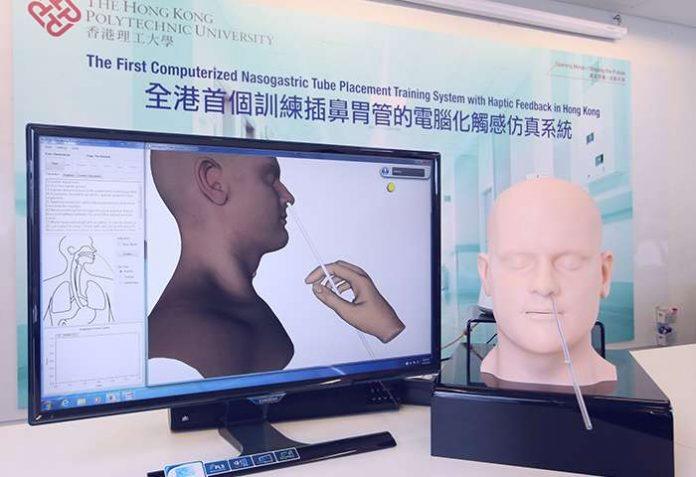A nasogastric tube is a narrow bore pipe passed into the stomach via the nose. This nasogastric tube is used for short-term or medium-term nutritional support. It is also used for the goal of stomach contents, for example, decompression of intestinal impediment. But, this nasogastric tube is not suitable for all patients such as high risk of aspiration gastric states, nasal injuries, and base of skull features. The whole process of inserting a thin, plastic tube via the nostril, down the esophagus nostril and into the stomach. Once, a nasogastric tube is in place, physicians can deliver food and medicine directly to the stomach or remove substances from it.
The school of Nursing of the Hong Kong Polytechnic University (Poly) has recently cultivated a computerized haptic system for Nasogastric tube (NGT) placement training. It allows nursing students to practice of NGT insertion in patient’s body through the computer simulated the virtual environment.
This system is the first computerized haptic system developed for training purpose in clinical skills in Hong Kong. This research is supported by General Research Fund (GRF) under Research Grants Council.
As Nasogastric intubation is the essential procedure for inserting a plastic tube into the stomach for feeding or drainage. After all, the placement of tube is a blind process in which tube may misplace anywhere inside the body. Therefore, it may cause unexpected complications or fatal incidents. Hence, the practice of placing tube method becomes very essential to every medical student.
Commonly, NGT placement training consists of lectures of theories in classrooms. Those lectures are conducted by a small group of clinical teaching with instructors professed the practical skills. This training conducted on the basis of low – constancy model. The model does not respond to the user, delivers human analysis realistically and supplies the actual sense of insertion forces.
How was the computerized haptic system developed?
This computerized virtual teaching system is developed with the application of force models to pretend NGT insertion and delivers the feedback forces through a haptic device. There are two methods was used to calculate the essential force. The first method is known as ‘Engineering Mechanics’. It involves the numerical calculation of the forces between the nasogastric tube and the nasogastric passage like they were constructed in engineering design.
The other system is known as ‘Expert system’. It leveraging the knowledge and experience of expert nursing professionals to calculate the forces. Through this method, the system can pretend the insertion forces at various location along the nasogastric passage, as well as the static and dynamic friction between the NGT and the nasogastric passage during the insertion process.
The computerized act can provide students with safe, standardized, repeatable and self- paced training with common feedback like gag and coughing of the simulator. It is done while NGT insertion for more realistic experimental learning and performance evaluation of the students. A graphical user interface is specially built inside the system to visually and virtually display, the tube position inside the body in supplementary. This is because to make the psychological and psychomotor training for the blind process, Determinable measurements in terms of completion time and insertion force applied during the virtual NGT placement. It provides feedback of how well they perform the NGT placement. All these function and learning occasions are not possible with conventional training using model.
According to Nursing professionals and academics, “This system will improve the skills of NGT placement of the students and advanced clinical nursing education.”
The research team will also improve the feature of the system by adding other simulated insertion outcomes. They are like coiling of NGT inside the mouth during insertion, rigorous body responses, movements of the virtual patient and to develop another high-fidelity simulator for the training of urinary and catheter insertion.
